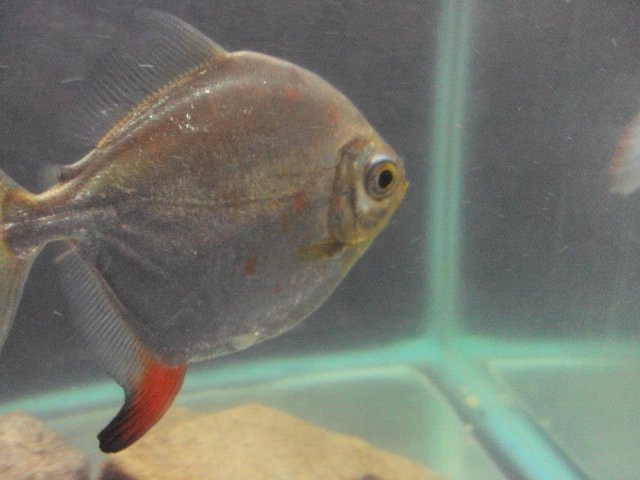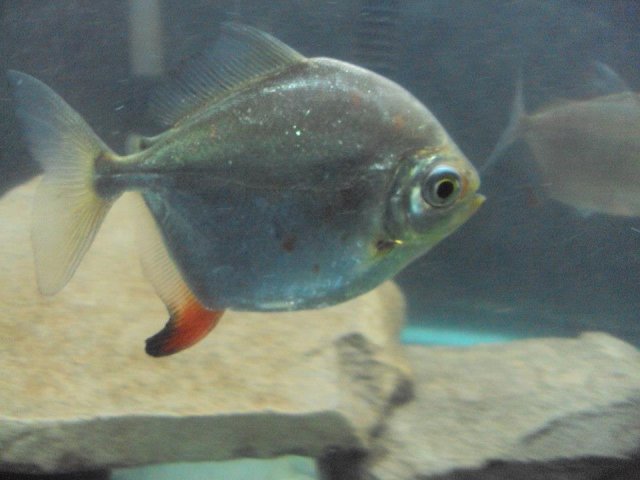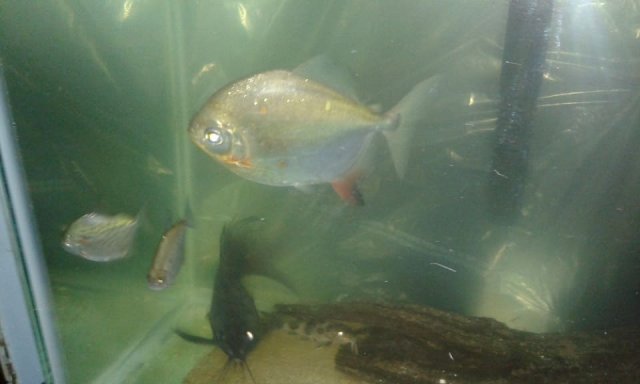A
AquaAlex1993
Guest


 Please enjoy a profile on one of my favorite fish.
Please enjoy a profile on one of my favorite fish.Redhook Silverdollar (Myleus Rubripinnis)
Common Name: Redhook, Red fin Silverdollar
Genus: Myleus
Family: Serrasalmidae (a family that includes Piranha, Pacu, Metynnis, Myleus, Myloplus, and Mylossoma)
Origin: Northern South America (Ecuador, Venezuela, Colombia, Peru, Brazil and more)
Care Level: Easy
Redhooks are very easy to keep provided that they are housed in an appropriately sized aquarium with plenty of filtration, clean water, and other redhooks as they are a schooling fish.
Full Grown Size: Up to 12’’
Diet: Myleus silverdollars are omnivores. This means that they will eat both meat and vegetables. Thus they are not picky eaters and will quickly learn to eat any and everything offered. Some examples of foods that I personally have found Redhooks to love include lettuce, market shrimp, bloodworms, blackworms and Krill. Provide them with the best quality pellet and flake food you can and mix in other goodies mentioned above.
For the best quality pellets and flake foods please check out: www.yourfishstuff.com
Tankmates: Redhook silverdollars are a schooling larger growing tetra that are suited for larger community aquariums. Redhooks should be kept in groups of 3 or more. You can also mix and match with other silverdollar species because in the wild many different silverdollar and pacu species are found swimming near each other in search of food and protection. Because of their larger growing size, I would personally avoid keeping these with smaller fish like neon tetras because there is always the risk of the redhooks having a snack. They pose no threat to other medium to larger fish. Hobbyists should be aware that occasional redhooks chasing each other is nothing to fret as this is common behavior in Myleus and their family in general and it is most likely a chance for them to establish a dominant redhook. Fish too large to be eaten are good tankmates! They can also be used as a dither for larger aggressive cichlids or monster fish tanks. Tank mates can include but not limited too: Other Myleus species, Metynnis species, Pacu, Flagtail Prochildous, Severums, Oscars, Angelfish, Chocolate Cichlids, Fancy Plecos, corydoras catfish, Arowanas, freshwater stingrays and the list goes on and on and on!
Tanksize: Due to the fact that they can grow up to 12’’ I would recommend a 75 gallon for a pair and larger for more. You can grow them out in smaller aquariums, however a big tank with lots of swimming space makes these guys thrive. 75 gallons to 1,000 gallons is the range for these guys. The more space the better.
Water Conditions: Very simple. P.H. 6.8-7.4 68-74 degrees F. Same water as any other hardy fish. You can use Amazon Blackwater aquarium solutions to create a natural biotope with other South American fish. Water changes should be done weekly.
AQUA ALEX’S FINAL REMARKS ON REDHOOK SILVERDOLLARS:
The Redhook Silverdollar is one of the most common Myleus species available in the aquarium hobby. With them being so common, some fish and pet stores will often confuse them with the common silverdollar (Metynnis Argenteus). But they are both 2 different fish, with the redhook having a much different body shape and look. A redhook silverdollar will have a black trimmed red anal fine (aka Hook) and be much more thicker wider and longer than a metynnis species.
As Redhook silverdollars mature, their coloration deepens. Redhooks may develop red spots, red patches and even red stomachs as they reach maturity.
It is normal for a newly add redhook silverdollar to be skittish upon arrival to it’s new fish tank. Leave the lights off for the full day when added to the aquarium. Make sure there are other silverdollars in the aquarium for it to feel safe.
For states where Piranhas are illegal to own, redhooks are your solution. Not only do they (and other Myleus) have the piranha look and shape but they are not aggressive and can in fact live with other fish while piranha can’t. Plus, redhooks are a LOT cheaper than piranha and are imported more frequently as well. Generally prices from juvenile redhooks can be anywhere from $12 to $20 depending on location and individual pet store and larger redhooks can vary from $30-$50 once again depending on the area you live and your pet store.
If you are looking for some activity in your predatory fish tank or monster fish tank, redhooks will add that activity. They constantly school and are always swimming. There presence will eventually draw your predatory fish out from hiding as they will realize that it is safe to come out because there is no bird or predators that would get them in the wild. Plus, no more food will go to waste. They attack like piranha when it’s feeding time.
These are one of my childhood comfort dream tropical fish and a fish I will always keep and recommend for someone looking for larger tetras.
If you have any further questions on Redhook silverdollars, please feel free to contact me and ask them.
If you don’t have any yet, consider adding a spark of red gold and silver to your aquarium!
Thanks for reading!
All the best!
Written and Produced by:
Aqua Alex Cardinale Exotic Tropical Fish with Aqua Alex © on AC Network


